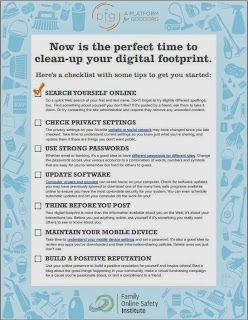[This is a targeted blog to Business School Members of California State University, Northridge Business and Economics school as a follow up to a presentation on polishing their online identity so it is professional and appropriate by the time they graduate.]
"POP" YOUR DIGITAL FOOTPRINT IN JOB SEARCHES
DEAR CSUN BUSINESS SCHOOL COBAE
CAREER EVENT ATTENDEES:
Thank you for
attending my presentation “Going Viral: Developing your Professional Online
Profile (POP)" at your California State University Northridge event last Friday,
November 15, 2013.
As promised, here are some career and reputation/profile links you may find useful when building your own Professional Online Profile (POP). I also wanted to remind you that now is a good time to clean up your Digital Footprint before you graduate. Below are just a few tips for managing or reducing some of the crumbs on your digital path before you enter the full-time job market.
Good luck and thanks again for attending!
Cynthia
PS--In you are interested in apply for an internship with CyberWise.org, please contact info@cyberwise.org.

_______________________________________________________________________
Tips for managing or reducing your digital footprint (via Ryan O. Hicks / @rohixx):
- Manage your online interactions with others.
- Take control of your privacy; set online accounts to private.
- Do not post what you would not want someone else knowing about you.
- Use caution in how you interact with others on social websites.
- Clean up your footprint - Remove photos, close online accounts, and delete old comments on websites and forums.
- Stop using the internet as a mindless hub for entertainment, and limit your activity.
- Google yourself and see what comes up.
- JustDelete Me
- Reputation.com
- Pipl
- Intelius
- White Pages
- Google Alerts
- PrivacyChoice
- Spokeo
- My Life
- Remove Your Name
- Reputation Champ
- Unroll.me
- Now is the Time to Clean Up Your Digital Footprint
- Creating and Maintaining a Professional Presence Online: A Roundup and Reflection
- Five first steps to using social media to find a job
- How to Develop a Professional Online Presence
LINKED IN
- LinkedIn Enters the College-Marketing Fray
- How To Create The Perfect LinkedIn Profile Blueprint
- How to Set Up your LinkedIn Profile
- Change is Constant, LinkedIn’s Latest
- Maximize your job search with LinkedIn Groups
- Don't just say it. Display it on your LinkedIn Profile: Illustrate your greatest achievements
COOL WAYS TO MAKE A RESUME: Create an Online Timeline or Infographic
Resume and more!
- Top 10 Free Timeline Creation Tools
- 20+ Tools To Create Your Own Infographic Resume
- 45 Creative Resumes to Seize Attention
- 20 Creative Virtual Resumes
PLUS
.JPG)


